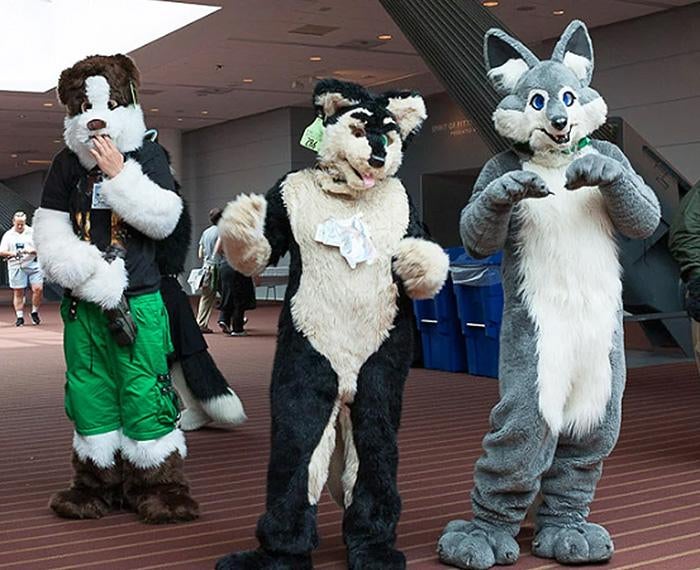
Subscribe to Pittwire Today
Get the most interesting and important stories from the University of Pittsburgh.Developmental psychologist studies subculture’s ‘fursuit’ of happiness

During this Fourth of July week and weekend in Pittsburgh, people are as likely to see paws, snouts and hooves as they are red, white and blue.
More than 7,500 furries from across the globe are converging on the David L. Lawrence Convention Center from July 5 to 8 for Anthrocon, the largest celebration of anthropomorphized characters in the world, now in its 13th year in Pittsburgh. And a team of Pitt psychologists will be studying them.
What’s a furry?
In a word, furries are fans. Much like Trekkies love Star Trek or sports fans create fantasy leagues, people who identify as furries are fans of art — cartoons, animation, costumes, puppetry, illustrations, performance, writing — that involves animals with human attributes. The fandom spans generations and manifests itself in as many ways as there are to be a fan of something.
Historically and culturally, anthropomorphism shows up all over the place: ancient Egyptian gods, Aesop’s fables, Harry Potter and Pokemon, nearly every Disney movie, Teenage Mutant Ninja Turtles. Folk and fairy tales, sports team mascots, insurance ads.
Yet furries are largely misunderstood. Popular media is quick to pigeonhole the community, said Rebecca McHugh, assistant professor of developmental psychology at the University of Pittsburgh at Bradford.
“The stereotypes tend to come in two different flavors,” she said. “Either they infantilize or they hypersexualize” — something largely true of most fandoms, she added. “And the community is not like that.”
As a result, furries tend to guard their privacy and choose carefully to whom they reveal their interests, McHugh said.
There are, however, a select group of researchers who have gained furries’ trust over the past decade, as McHugh found out when she first contacted Anthrocon organizers about doing a study. Furscientists write peer-reviewed papers. They go to conferences. And they helped the Pitt team get connected.
Behind the fursona
McHugh focuses on what psychologists call visibility management: when, how and why people choose to reveal certain stigmatizing elements of their lives to others. She did her dissertation work on visibility management in depressed teenage girls. “It is identity, but it’s also social interaction and decision making,” she said.
Last year at Anthrocon, she and two students, Mikayla Brinker and Anni Frick, interviewed furries one-on-one and in groups. For Brinker and Frick, it was also an exercise in conducting qualitative research.
They asked people who may or may not have been “out” as furries at home how and why they came to the convention, what got them interested in furry culture, who in their lives knew about their interests and who didn’t and why, and if they had any advice to those coming into the community.
They then spent a year presenting at conferences, writing papers and coding data (Frick, now a psychology graduate student at Chatham University, received an undergraduate summer research grant for this aspect). Qualitative research takes a long time, McHugh stressed.
One paper in progress situates the modern furry fandom within a religious, cultural and historical context. “Mythology and religion [are] just laden with these types of characters,” McHugh said, not to mention the myriad modern examples. “I’m not sure why people are being stereotyped when these characters are so wildly popular.”
A second paper looks at the visibility management process, drawing on McHugh’s background. “So many people face stigma and stereotype and don’t really know how to cope. They feel torn between hiding a very important part of themselves and having social connection. That’s really what it comes down to.”
Her ultimate goal with that line of research, McHugh said, is “to help disrupt any stereotype, any stigma, by pointing out that it’s harming people, by pointing out its fallacies and its incorrectness, and by helping people who are facing those things to deal with them.”
Brinker, now a graduate student in counseling psychology at Robert Morris University, is taking the lead on a third paper about identity formation through young adulthood and its connection to the furry fandom.
And the research continues this year. Pitt–Bradford undergraduate Darien Talley will go with McHugh to Anthrocon this weekend. She’ll train in interview techniques while McHugh explores emerging themes from last year’s research.
The intergenerational component of the fandom and how it’s communicated is of particular interest. Hosting an “Ears, Nose & Toes” family fun craft hour, McHugh hopes, will provide a chance to talk with parents, both furry and not.
While not a furry herself, McHugh said she was most surprised by the warmth of the community and amazed at the welcome she received from both furries and furscientists. She said she’s excited to continue helping them tell their tales.


